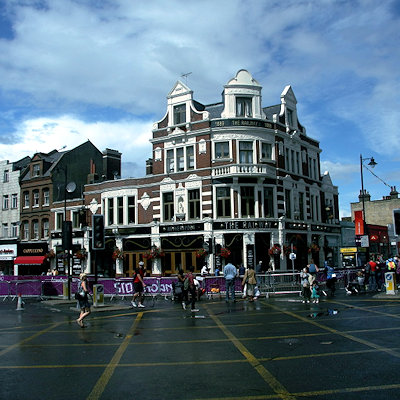
Like us on Facebook
PLACE NAMES


 
|
|
Putney
|

|
|
 | Old Town Hall, Whittaker Avenue, Richmond - 020 8940 9125
St. Paul's Churchyard, London - 020 7332 3456
visit@cityoflondon.gov.uk
|
Putney is an ancient parish which covered 9.11 square kilometres (3.52 sq mi) and was until 1889 in the Hundred of Brixton in the county of Surrey. Its area has been reduced by the loss of Roehampton to the south-west, an offshoot hamlet that conserved more of its own clustered historic core. In 1855 the parish was included in the area of responsibility of the Metropolitan Board of Works and was grouped into the Wandsworth District. In 1889 the area was removed from Surrey and became part of the County of London. The Wandsworth District became the Metropolitan Borough of Wandsworth in 1900. Since 1965 Putney has formed part of the London Borough of Wandsworth in Greater London.
The benefice of the parish remains a perpetual curacy whose patron is the Dean and Chapter of Worcester [Cathedral].
The church, founded in the medieval period as a chapel of ease to Wimbledon, was rebuilt in the very early Tudor period and in 1836 was again rebuilt, and the old tower restored. It has a small chantry chapel (originally erected by native Nicholas West, Bishop of Ely (d. 1533)) removed from the east end of the south aisle, and rebuilt at the east end of the north side, preserving the old style. In 1684, Thomas Martyn bequeathed lands for the foundation and support of a charity school for 20 boys, sons of watermen; and by a decree of the court of chancery in 1715, the property was vested in trustees. A charitable almshouse for 12 men and women, dedicated to the Holy Trinity, was erected by Sir Abraham Dawes, who provided it with an endowment.
Putney was also birthplace of Thomas Cromwell, made Earl of Essex by Henry VIII and of Edward Gibbon, author of the Decline and Fall of the Roman Empire, who was born in 1737. John Toland, a noted free-thinking writer died and was buried at Putney in 1722; and later that century Robert Wood, under-Secretary of State for the Southern Department, who published The Ruins of Palmyra about the Roman ruins he visited there at Baalbek in Syria, and other archæological works lies here. William Pitt, Earl of Chatham, died at a house on Putney Heath.
In the 1840s Putney was still a part-wooded, part-agricultural village focussed closest to the Thames, opposite to Fulham, with which it was connected by a wooden bridge; it was street-lit with gas, partly paved, and well supplied with water. At that time Putney took on London's premier role in civil engineering. The College for Civil Engineers relocated to Putney in 1840, for the purpose of affording sound instruction in the theory and practice of civil engineering and architecture, and in all those branches of science and learning which are adapted to the advanced state of society, and constitute an education that fits the student for any pursuit or profession.
Putney had a second place of worship, for Independents and Roehampton was in the process of achieving separate parish status. The proprietors of the bridge distributed £31 per annum to watermen, and watermen's widows and children; and the parish received benefit from Henry Smith's and other charities.
Putney appears in the Domesday Book of 1086 as Putelei. It was noted that it did not fall into the category of local jurisdictions known as a manor, but obtained 20 shillings from the ferry or market toll at Putney belonging to the manor of Mortlake.
The ferry was mentioned in the household accounts of Edward I (reigned 1272-1307): Robert the Ferryman of Putney and other sailors received 3/6d for carrying a great part of the royal family across the Thames and also for taking the king and his family to Westminster.
One famous crossing at Putney was that of Cardinal Wolsey in 1529 upon his 'disgrace' in falling out of favour with Henry VIII and on ceasing to be the holder of the Great Seal of England. As he was riding up Putney Hill he was overtaken by one of the royal chamberlains who presented him with a ring as a token of the continuance of his majesty's favour. When the Cardinal had heard these good words of the king, he quickly lighted from his mule and kneeled down in the dirt upon both knees, holding up his hands for joy, and said "When I consider the joyful news that you have brought to me, I could do no less than greatly rejoice. Every word pierces so my heart, that the sudden joy surmounted my memory, having no regard or respect to the place; but I thought it my duty, that in the same place where I received this comfort, to laud and praise God upon my knees, and most humbly to render unto my sovereign lord my most hearty thanks for the same."
The first bridge of any kind between the two parishes of Fulham and Putney was built during the Civil War: after the Battle of Brentford in 1642, the Parliamentary forces built a bridge of boats between Fulham and Putney. The first permanent bridge between Fulham and Putney was completed in 1729, and was the second bridge to be built across the Thames in London (after London Bridge).
|
 Feel free to Email me any additions or corrections Feel free to Email me any additions or corrections
LINKS AVAILABLE TO YOUR SITE
| |





